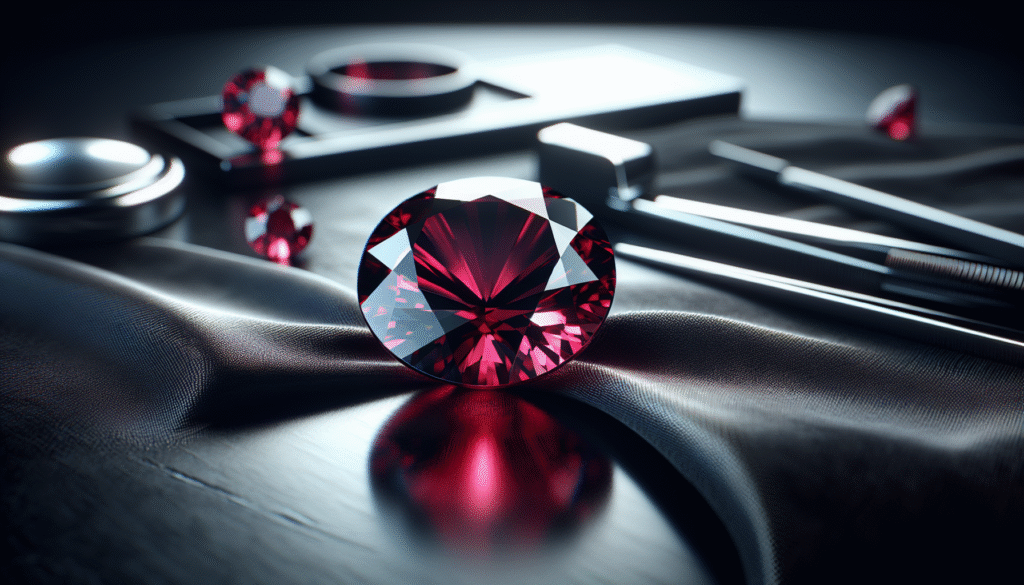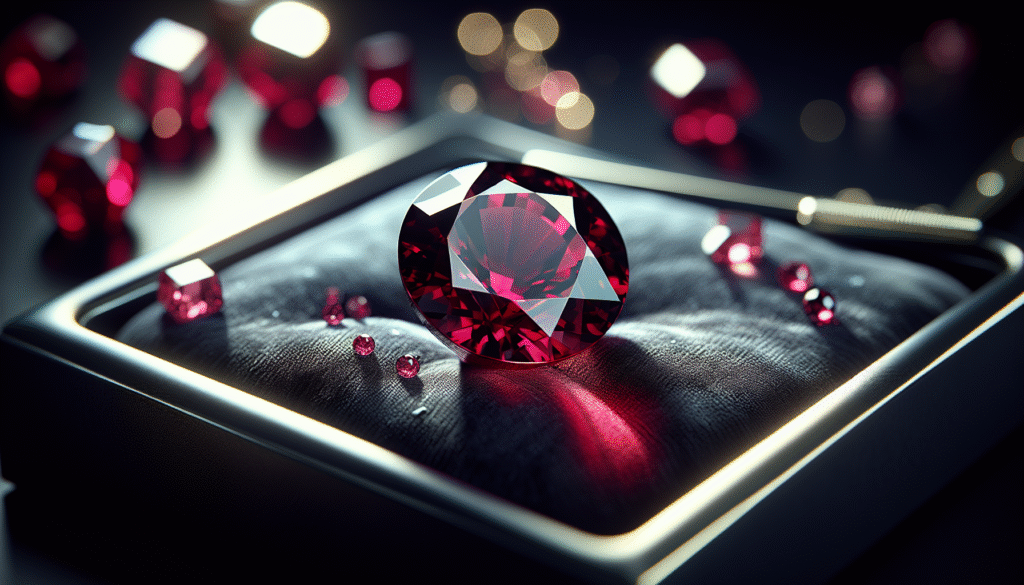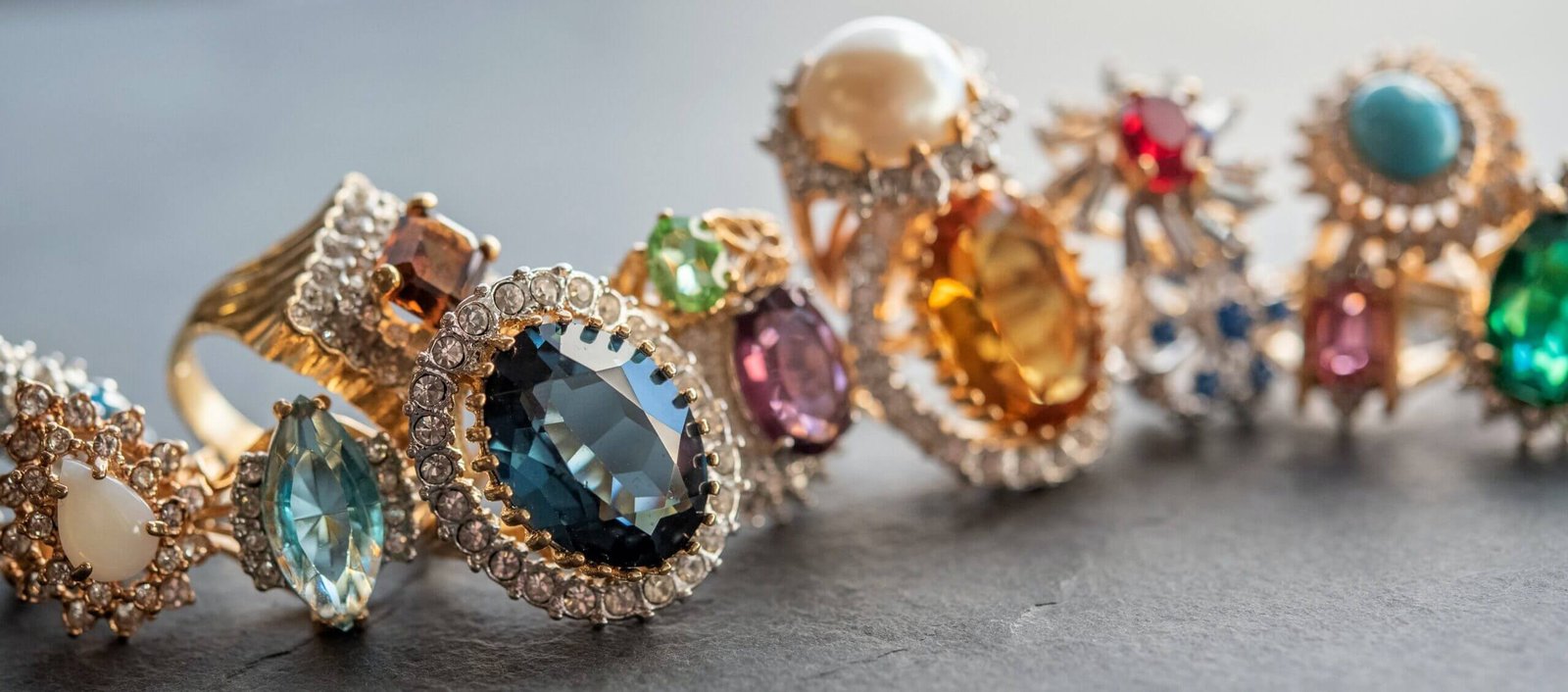Have you ever stood in front of a glass case, squinted at a tiny red stone, and wondered what it would take to make that pebble worth your rent for a month?

What Is a Ruby?
You probably already know that a ruby is a red gemstone, but there’s more to it than that. A ruby is the red variety of the mineral corundum (aluminum oxide), colored by traces of chromium; commercially and culturally it sits at the same high table as sapphires, emeralds, and diamonds.
Why People Care About Ruby Value
You might be buying a ruby as a gift, an heirloom, or as an “investment” you’ll regret later if the market shifts. Understanding value saves you from paying for marketing or sentiment instead of quality, and it helps you decide whether to insure, sell, or wear the stone like it was made to be worn.
The Basic Rules of Ruby Valuation
There are several variables that combine to set the price of a ruby, and you’ll meet them in any conversation with a jeweler: color, clarity, cut, carat weight, origin, and treatments. You can think of these as ingredients in a recipe; a single exceptional ingredient can make the dish extraordinary, but most rubies are reasonably good at several things rather than perfect at one.
Color
Color matters more than anything else for rubies. You’ll hear phrases like “pigeon’s blood,” “vivid,” and “paler,” and they’re not just flowery adjectives — they’re shorthand for huge price differences.
- Hue: The primary hue should be red; a slight purplish or orangey tint can significantly influence price.
- Tone: This is how light or dark the stone appears. Too light and it looks like a pink sapphire; too dark and it looks blackish.
- Saturation: This measures intensity. High saturation is the golden goose for gem dealers.
If you find a ruby with a pure, vivid red and medium tone — often called “pigeon’s blood” when it’s particularly saturated and desirable — your wallet will feel lighter soon enough.
Clarity
Unlike diamonds, which prize near-perfection, rubies routinely carry inclusions. You’ll be judging inclusions for their effect on transparency and beauty. A heavily included ruby that leaks light and looks cloudy will be worth a lot less than one with tiny, benign inclusions.
You should know that some inclusions actually help prove natural origin. If a ruby were completely flawless, you might suspect it’s synthetic or has been heavily treated.
Cut
Cut affects how the ruby faces the world — how light enters, bounces, and returns to your eye. Unlike diamonds, rubies are cut to preserve weight and color rather than to maximize brilliance. Expect a range of shapes and cuts, and remember that a well-cut, smaller ruby will often look better and be worth more than a badly cut, larger one.
Carat Weight
One carat equals 200 milligrams, and as with most gemstones, price increases disproportionately with size. You’re not just paying for extra mass; you’re paying for rarity. A 3-carat fine-quality ruby is rarer and more expensive per carat than three 1-carat rubies of the same quality.
Origin
Origin carries a real price premium. Rubies from certain regions, most notably Myanmar (Burma), are historically prized and command higher prices. You’ll also see rubies from Thailand, Madagascar, Mozambique, and Vietnam — each with characteristic colors and market perceptions.
Treatments
Treatment status is central. You’ll want to know whether a ruby is untreated, heat-treated, or subjected to more invasive treatments like lead-glass filling. Treatments alter durability, appearance, and value.
- Untreated rubies with top color and clarity are the rarest and most expensive.
- Heat treatment is widely accepted and improves color and clarity; it’s expected in many stones.
- Lead-glass filling dramatically improves appearance but reduces durability and value; such stones are worth much less and should be disclosed.
Quick Reference Table: What Affects Value (At a Glance)
| Factor | What You Should Look For | Effect on Value |
|---|---|---|
| Color | Pure, vivid red; medium tone; strong saturation (pigeon’s blood is top) | Biggest single driver of price |
| Clarity | Some inclusions acceptable; avoid cloudiness or large fractures | Moderate to large effect |
| Cut | Proportional face-up appearance; maximizes color and weight | Moderate effect |
| Carat | Larger sizes increase price per carat | Significant effect |
| Origin | Burmese (high premium), Mozambican, Thai, Madagascar, Vietnamese | Can add premium for certain origins |
| Treatment | Untreated > heat-treated > filled/treated | Treatments can reduce value substantially |
| Certification | GIA, SSEF, AGTA reports increase buyer confidence | Adds to perceived and real value |
Price Ranges: What Rubies Sell For
You’ll find huge variability, so think in ranges. The table below gives approximate retail prices per carat as of recent years. These are broad and can vary by market, lighting, and whether the seller is trying to sell you a story along with the stone.
| Quality | 0.5–1.0 ct (USD/ct) | 1.0–2.0 ct (USD/ct) | 2.0–5.0 ct (USD/ct) | 5.0+ ct (USD/ct) |
|---|---|---|---|---|
| Commercial (heated/filled) | $50–$400 | $80–$500 | $100–$800 | $200–$1,000 |
| Good (heated, decent color) | $300–$1,200 | $400–$2,000 | $800–$4,000 | $1,200–$6,000 |
| Fine (strong color, treated) | $1,200–$3,500 | $2,000–$8,000 | $4,000–$20,000 | $6,000–$50,000 |
| Top (untreated, pigeon’s blood, Burmese) | $8,000–$20,000 | $20,000–$100,000 | $50,000–$500,000+ | $100,000–$1,000,000+ |
These figures are illustrative. You should treat them as a starting point rather than a rule. Magnificent stones in museums can exceed these by orders of magnitude.
“Pigeon’s Blood” — What It Really Means
When someone uses the term “pigeon’s blood,” they’re signaling a ruby of rare, vivid red — often with a slight blue undertone. You’ll hear this applied most often to classic Burmese rubies and it’s the shorthand for “I will mortgage a small part of my life for this.” It’s evocative, subjective, and expensive.
Treatments Explained
You’ll want to know what treatments have been used and whether they’re stable. Treatments often determine whether a ruby is wearable or risky for daily use.
Heat Treatment
Heat treatment is the standard practice. It improves color and clears some inclusions. It’s considered acceptable and common; most rubies on the market are heat-treated and still retain good value.
Fracture Filling / Lead-Glass Filling
This is a more invasive treatment where voids and fractures are filled with a glassy substance — sometimes containing lead — to improve appearance. The result can be dazzling, but the treatment reduces durability and resale value. You cannot subject such stones to high heat or harsh chemicals.
Diffusion Treatment
Certain diffusion treatments attempt to alter the surface color by introducing coloring agents at high temperature. This is often viewed unfavorably because the alteration penetrates only near the surface.
Dyeing and Coating
These are lower-grade treatments that artificially enhance color and are generally frowned upon in fine jewelry markets. They can be unstable and fade.
Synthetic and Lab-Grown Rubies
Synthetic rubies exist and can be beautiful and inexpensive. You’ll see flame-fusion (Verneuil), flux-grown, and hydrothermal synthetics. They’re chemically corundum, but because they’re lab-grown they are worth much less than comparable natural rubies. You should always ask for disclosure and a lab report if origin matters to you.
Table of Treatments and Their Implications
| Treatment | How It Changes Stone | Durability | Market Impact |
|---|---|---|---|
| Untreated | Natural color and inclusions | Highest durability | Highest value (if top color) |
| Heat | Improves color / clarity | Stable | Widely accepted; moderate value |
| Lead-glass filling | Fills fractures; can look excellent | Reduced; sensitive to heat & chemicals | Major value reduction; must be disclosed |
| Diffusion | Surface color change | Surface only; less durable | Usually less accepted; lowers value |
| Dyeing/coating | Artificial color enhancement | Not durable | Lowers value significantly |
| Synthetic (Verneuil, flux) | Looks similar to natural | Stable | Lower value; should be disclosed |
How to Tell If a Ruby Is Real or Synthetic
If you’re not a gemologist, you can still ask practical questions and make smart observations.
- Ask for a lab report from a respected lab (GIA, SSEF, AGL).
- Look under a loupe: synthetics often have curved growth lines or gas bubbles; natural ones show mineral inclusions and needle-like rutile (silk).
- Color zoning and natural inclusions are not defects; they’re clues.
- Fluorescence can help: many rubies fluoresce red under UV light, but this isn’t definitive.
Certification — Why It Matters
You’ll want to insist on a certificate for significant purchases. A reputable lab report identifies whether the ruby is natural or synthetic, what treatments have been applied, and often (with varying certainty) the origin.
- GIA reports are widely respected for clarity and consistency.
- SSEF and AGL are known for in-depth analysis and are respected in high-end markets.
- Reports will list treatments and sometimes estimated origin; origin statements are opinion-based and less certain than treatment identification.
Buying Tips — How to Get a Good Deal
You don’t need to be rude to negotiate, but you should be prepared.
- Buy from reputable dealers who will provide documentation, warranties, and a return policy.
- Compare stones by face-up appearance rather than relying on carat alone.
- Ask about treatments and see the report. If the seller balks, walk away.
- Check the setting: sometimes a lower-quality ruby is made to look better by an expensive setting.
- Ask to see the stone under different lighting: daylight and incandescent lamps can change how color appears.
- If buying online, request high-resolution photos and a video showing movement and light return.
A little anecdote: you’ll notice how people behave around rubies. They tend to become more eloquent, as if color itself has granted them a legal right to an opinion. If someone starts waxing poetic about “the ancient fires” of their stone, ask about the lab report.
Selling and Resale Value
You might be thinking of buying a ruby as an investment. Here’s the reality: extraordinary, untreated rubies from top origins can increase in value and are collectible. Ordinary rubies — those that are heat-treated or filled — do not appreciate rapidly and are better seen as jewelry than as financial assets.
- Liquidity varies: market for top-quality rubies is limited and specialized.
- Provenance, treatment, and certification affect resale.
- Auction houses may fetch high prices for rare, documented stones.
If you buy expecting quick financial gains, you’re likely to be disappointed unless you truly understand market nuances.

Care and Wearing
Rubies are hard (9 on the Mohs scale) but not invulnerable. They can chip or fracture if struck.
- Clean gently with warm soapy water and a soft brush; avoid ultrasonic cleaners if the stone is fracture-filled.
- Avoid extreme heat or sudden temperature changes, especially with filled or coated stones.
- Regular inspections by a jeweler can catch issues early.
If your grandmother’s ruby ring has been in the family since the 1920s, treat it like an old actor: careful, admired, and rarely left alone with the dishwasher.
Ethics, Origin, and Traceability
You should care about how the ruby was mined. Minerals can be tied to human rights abuses, environmental damage, and conflict. Rubies are not covered by the Kimberley Process (which applies to diamonds), so provenance and responsible sourcing rely on industry standards and your vigilance.
- Ask dealers about their sourcing policies and whether they participate in responsible sourcing initiatives.
- Be cautious of origin claims without lab reports or chain-of-custody documentation.
- Sanctions on Burmese gemstones have been fluid; commercial Burmese rubies may carry additional ethical concerns depending on the political context.
If you want the comfort of a clean conscience with your jewelry, ask questions and be willing to pay a slight premium for verified, responsibly sourced material.
Common Imitations and Alternatives
You’ll find stones masquerading as rubies or offered as cheaper alternatives. Knowledge saves embarrassment and money.
- Synthetic rubies (Verneuil, flux) — gemologically corundum but lab-grown.
- Glass — cheap imitations that can look convincing under casual inspection.
- Red spinel, garnet, tourmaline — natural stones that can mimic ruby color but are distinct minerals.
- Sapphires that are pink to red — sometimes marketed as “pinkish” stones.
If your seller uses words like “looks like a ruby” without the lab report, assume it’s not a natural ruby of that price.
Insurance and Appraisals
If you buy a ruby of substantial value, insure it. Get a professional appraisal that details the stone, its treatments, and its replacement value. Photographs and documentation should be stored securely.
- Replacement value can be higher than purchase price because retail markup and market conditions matter.
- Keep the certificate and appraisal with your insurance records.
Negotiation Strategies
You can negotiate politely and effectively.
- Point out comparable stones and reports.
- Ask for small price reductions or for the seller to include an upgrade in the setting.
- Be willing to walk away; scarcity is one thing, desperation is another.
A good dealer will respect an informed buyer. A pushy dealer will pressure you to accept a “special” price and then vanish when you ask for paperwork.
How to Read a Lab Report
A lab report will usually include: weight, measurements, cut, color description, treatments detected, and often a photograph. You should look for:
- Specific mention of “natural origin” versus “synthetic.”
- Explicit description of treatments (heat, filling, diffusion).
- Any statements of origin — these are informed opinions rather than certainties.
If a report is vague, ask the laboratory or dealer for clarification.
Practical Examples (What You Might Encounter)
Imagine you’re in a small jewelry shop. Two rubies sparkle under different lights. One is 1.2 ct, bright red, heat-treated, and set in a modest gold ring. The other is 0.9 ct, a darker, purpler red, untreated, with a cloudy inclusion. Which is more valuable? The answer depends on color and market preference: the bright, well-cut, treated stone might be more appealing and sell more easily despite the lack of “untreated” status. You’ll want to examine both and ask for certificates — beauty and value are sometimes different animals.
When an Appraisal Can Mislead You
An appraisal is only as good as the appraiser. Retail appraisals often reflect replacement (retail) value, not market resale value. If you sell to a dealer, you’ll get wholesale, which is lower. If you insure for replacement, that’s fine; don’t confuse replacement cost with resale proceeds.
Investment Considerations
You might imagine rubies as tiny red gold bars, but the market isn’t as standardized as for diamonds. High-end, documented, untreated Burmese rubies are collectible and can perform well. Lower-tier stones are not sound investments.
- Diversify if you’re investing in gemstones.
- Keep documentation, provenance, and lab reports.
- Understand that liquidity may be limited.
If you want to invest, consult a market-savvy gemologist or a reputable auction house before you commit.
Red Flags to Watch For
You should be skeptical if:
- A seller refuses to provide a lab report.
- The price seems suspiciously low for the claimed quality.
- The stone reacts poorly to a light source or looks glassy under magnification.
- The vendor uses vague language like “treated to improve appearance” without specifics.
Trust your instincts and the paperwork.
Final Checklist Before You Buy
- Ask for a certificate from GIA, SSEF, or equivalent.
- Confirm treatment type and whether it’s stable.
- View the ruby under multiple lights and magnification.
- Compare similar stones and prices.
- Ask about return policy and warranty.
- Consider ethical sourcing and provenance.
Conclusion — What Gives a Ruby Its Value
You’ll find that color, clarity, cut, carat weight, origin, and treatments combine to make every ruby unique. The color is king, but provenance and treatment determine whether the stone will open doors at auction or simply look pretty in a ring box. If you buy thoughtfully — with documentation, inspection, and a little skepticism — you can enjoy your ruby’s beauty and know reasonably well what you paid for it and why.
And if you keep it long enough, you might tell the next person who asks you about its value that it was worth every dollar — not because of the number on the receipt, but because of the way it looks when sunlight catches it and makes you pretend you understood color grading all along.



